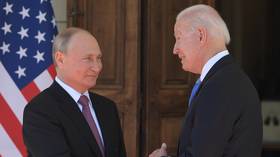Putin-Biden talks: Is there any hope for compromise?

With Russian President Vladimir Putin set to hold talks with his American counterpart, Joe Biden, on Tuesday, there is no doubt that Ukraine is high on the list for urgent discussion after weeks of escalating rhetoric.
Washington and Kiev have been warning about the prospect of Moscow ordering a large-scale invasion, with NATO rallying around the Eastern European country and issuing increasingly stark warnings. The Kremlin, however, denies any such plans are afoot, and has instead accused Ukraine and its Western backers of staging a series of provocations, while manufacturing a disinformation campaign.
As so often with Russia, the media storm has lost touch with the facts. Remember, for instance, the “bounties” Moscow allegedly paid for Americans killed in Afghanistan? Widely disproven. The so-called “Steele Dossier” that painted former US President Donald Trump as a Russian agent? Made-to-order rubbish.
In fact, talk of a large-scale Russian invasion is speculative. Even American officials admit that they cannot actually predict it, while interpreting Russian troop movements as a precursor to it. It is easy to see why Ukraine’s leadership may be interested in magnifying a Russian threat at this moment: President Volodymyr Zelensky is losing popularity and under great pressure from domestic opponents. As it did for his predecessor, Petro Poroshenko, stressing outside dangers may appear as a promising distraction.
Washington as well may have some domestic concerns to divert attention from. After initially receiving great advance credit simply for not being Donald Trump, Biden is now facing tumbling ratings. A cynic might suspect a case of talking-up an invasion scheme to take credit when the attack no one meant to launch does not happen.
Yet there are real reasons for worry, as Russian foreign minister Sergey Lavrov has pointed out, due to three important contexts:
In narrow terms, Russia, on one side, and Ukraine and the West on the other, do not see eye to eye on how to implement the 2014 Minsk II agreement. Since it is the only agreed blueprint for ending the Ukraine crisis, the crisis cannot end. The second, wider context is that Russia refuses to accept the security-geopolitical realignment of Ukraine with the West. Moscow has laid down “red lines”: it will tolerate neither a Ukrainian NATO membership nor a de facto military integration via intensifying cooperation, arms sales, and infrastructure.
Finally, most fundamentally, both Moscow and the West are struggling to find a stable place for a Russia that is no longer anomalously weak, as in the 1990s, but also not as powerful as the former Soviet Union in the long 1970s. Russia is back, but no one has yet figured out what exactly that means. One thing is clear: Moscow remembers the broken assurances of NATO non-expansion of 1990 and 1993 and is now demanding guarantees that the alliance will stop its eastward march.
It is these stakes that mean that talk of escalation is not, unfortunately, baseless. The attitude dominating much Western discussions is primitive – insisting that Ukraine is a sovereign state and can join any alliance it wants, and that NATO won’t allow Russia to veto its decisions sounds fashionably resolute, but is, actually, not only a dead-end but poor thinking, too.
Of course Ukraine is a sovereign state. But it is not a “natural right” of such states to join any alliance they like. Concretely, Ukraine has a right to ask for NATO membership. It is not a good idea, but Kiev may exercise its sovereignty by making bad choices. Yet Ukraine has no right to admission. That can only be granted by a unanimous decision of all current NATO members, each of which has the right to say no. Those who spread the false impression that Ukraine’s sovereignty would be infringed if NATO did not let it join denigrate the rights of all current NATO members to object, which we could understand as diminishing their own precious sovereignty.
Second, stating, like the reliably pedestrian NATO Secretary General Jens Stoltenberg, that NATO does not owe Russia a “veto” is banal. Of course it does not. But even if Russia has no “veto,” NATO may still have good reasons, of its own, to take Moscow’s point of view seriously. It should even leave itself the option of agreeing with it, at least sometimes.
Third, that is why it is so disturbing to find Stoltenberg going even farther by adding that Russia “has no say” either. Sounds tough. Yet what does it even mean? That Russia does not have a vote because it is not a NATO member? Frankly, he is missing the point again.
That is because a useful relationship with Russia – like all good diplomacy – is not built on granting each other vetoes or votes, but on taking the other’s concerns and interests sufficiently into account not to rule out compromise. Even when – in fact, precisely when – these concerns and interests do not carry the authority of contractually granted “vetoes” and “votes.” It is bemusing to see a NATO secretary general so confused about the elementary facts of life between states.
And finally, Stoltenberg informs us that Russia has “no right to a sphere of influence” or to try “to control its neighbors.” Here Stoltenberg obfuscates a crucial distinction: facing the fact that Moscow cannot accept, in Dmitry Trenin’s words, Ukraine being turned “into a US-controlled unsinkable aircraft carrier parked on Russia’s border just a few hundred miles from Moscow” is not the same as conceding Russian control over Ukraine.
This is important because it is typical of much lazy Western thinking. Instead of exploring the space for compromise that opens up when both sides make concessions, Stoltenberg conflates any concessions with wholesale surrender and, even worse, betrayal. Even listening to Russia, to this thoroughly emotionalized, somewhat jejune approach, is already akin to selling out Ukraine.
In reality, a genuine compromise is possible. In very rough outline: NATO stops expanding. That is not a tough demand: The alliance has already added 14 members to the 16 it had at the end of the Cold War. Maybe once it has essentially doubled its membership, it can rest and digest?
Moreover, NATO’s decision to close the door would be just that – NATO’s. Kiev might find it disappointing but since it has never had any right to membership, Ukraine would not lose an iota of sovereignty.
Russia would have to agree to accept an essentially neutral Ukraine retaining a privileged relationship with the EU and never joining Moscow’s Eurasian Economic Union.
Inside Ukraine, the separatist areas would have to be reintegrated via a mixture of amnesties, internationally supervised elections, and special status. This can be done without a wholesale decentralization that would undermine the Ukrainian state, a horror scenario much abused by those who do not want a compromise anyhow. Finally, Crimea would be the hardest issue and may require an agreement to disagree, for a long time.
Yet here is the real catch. It would be insanely optimistic to believe that the above – or anything similar – is possible now. Trust has collapsed; intransigence dominates; diplomacy and compromise are routinely denounced as appeasement. Leaders are captives – often willingly – of their own rhetoric and tough images. Putin, remember, is not the only one (occasionally) wearing aviator shades. So does Joe Biden, who made a point of presenting a pair to the Russian president at their last meeting in Geneva.
President Biden, for one, has already announced that he won’t accept any Russian red lines. And to be fair, how could he? His Congress and media would tear him to pieces. Never mind that the US habitually lays down red lines of its own – and all over the world, not just in its neighborhood.
At the same time, everyone who is not completely bereft of reason or conscience knows that further escalation would be catastrophic, for Ukraine and far beyond. Yet, for now, this crisis has no solution. An end may be closer than we think, but it may also be far off, and it is certainly not in sight. Where a conflict cannot be resolved by either fighting or a conclusive settlement by negotiation, what is left is temporary compromise. Could NATO, for instance, give written assurances not to stop but suspend expansion – de jure and de facto – for a period of time agreed between it and Russia? Could Russia, in return, give the same type of assurances that it sees no need to further concentrate large, potentially offensive forces on Ukraine’s borders?
The decisive alternative in play is not, actually, the one between “hard” and “soft” lines or, to use classical Cold War terminology, the preferences of the “hawks” and “doves.” What really matters is the distinction between short-term and long-term thinking, or, if you wish, impatience and patience.
It is that fundamental impasse that will likely forestall any chances of a proper, lasting compromise when Biden and Putin meet later on Tuesday. Any long-term answers might be off the cards, but we can still hope for some short-term relief if cooler heads prevail.
The statements, views and opinions expressed in this column are solely those of the author and do not necessarily represent those of RT.
The statements, views and opinions expressed in this column are solely those of the author and do not necessarily represent those of RT.













